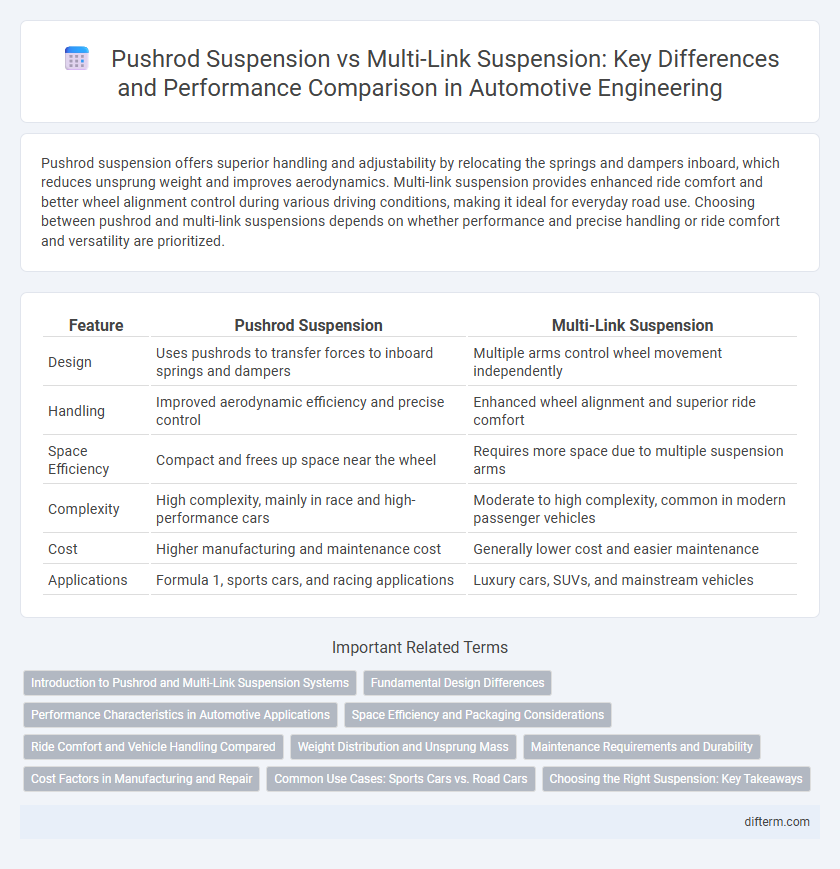Pushrod suspension offers superior handling and adjustability by relocating the springs and dampers inboard, which reduces unsprung weight and improves aerodynamics. Multi-link suspension provides enhanced ride comfort and better wheel alignment control during various driving conditions, making it ideal for everyday road use. Choosing between pushrod and multi-link suspensions depends on whether performance and precise handling or ride comfort and versatility are prioritized.
Table of Comparison
| Feature | Pushrod Suspension | Multi-Link Suspension |
|---|---|---|
| Design | Uses pushrods to transfer forces to inboard springs and dampers | Multiple arms control wheel movement independently |
| Handling | Improved aerodynamic efficiency and precise control | Enhanced wheel alignment and superior ride comfort |
| Space Efficiency | Compact and frees up space near the wheel | Requires more space due to multiple suspension arms |
| Complexity | High complexity, mainly in race and high-performance cars | Moderate to high complexity, common in modern passenger vehicles |
| Cost | Higher manufacturing and maintenance cost | Generally lower cost and easier maintenance |
| Applications | Formula 1, sports cars, and racing applications | Luxury cars, SUVs, and mainstream vehicles |
Introduction to Pushrod and Multi-Link Suspension Systems
Pushrod suspension systems use a lever mechanism to transfer wheel motions to inboard-mounted springs and dampers, optimizing space and reducing unsprung mass for improved handling. Multi-link suspensions feature multiple arms controlling wheel movement independently, enhancing ride comfort and precise wheel alignment during various driving conditions. Both systems offer unique advantages in performance and adaptability, with pushrod suspensions commonly found in high-performance and racing vehicles, while multi-link setups are prevalent in modern passenger cars for balanced comfort and control.
Fundamental Design Differences
Pushrod suspension features a simplified design utilizing rocker arms and pushrods to transfer wheel movement to inboard springs and dampers, minimizing unsprung weight and improving aerodynamic efficiency. Multi-link suspension employs multiple arms and links to individually control wheel motion, offering enhanced flexibility in adjusting camber, toe, and handling characteristics. The fundamental difference lies in pushrod's indirect motion transfer favoring lightweight performance setups, whereas multi-link provides complex geometry for superior ride comfort and precise wheel alignment.
Performance Characteristics in Automotive Applications
Pushrod suspension systems excel in high-performance automotive applications by offering precise wheel control and reduced unsprung weight, enhancing handling and responsiveness. Multi-link suspension provides superior ride comfort and versatility through independent wheel movement and optimized geometry for varied road conditions. Both systems impact vehicle dynamics differently, with pushrod favoring track performance and multi-link prioritizing balanced everyday drivability.
Space Efficiency and Packaging Considerations
Pushrod suspension offers superior space efficiency by relocating dampers and springs away from the wheel area, allowing more compact packaging within the chassis. Multi-link suspension occupies more space due to multiple arms requiring clearance for complex movement, limiting design flexibility in tight vehicle compartments. Engineers prioritize pushrod setups in performance and race cars to maximize aerodynamic bodywork and optimize center of gravity.
Ride Comfort and Vehicle Handling Compared
Pushrod suspension offers precise vehicle handling by minimizing unsprung weight and enhancing responsiveness, making it ideal for high-performance automotive applications. Multi-link suspension provides superior ride comfort through independent wheel movement and advanced damping, effectively absorbing road irregularities. Both systems balance handling and comfort differently, with pushrod prioritizing agility and multi-link optimizing smoothness and stability.
Weight Distribution and Unsprung Mass
Pushrod suspension systems contribute to improved weight distribution by relocating suspension components closer to the vehicle's center of gravity, enhancing handling and stability. In contrast, multi-link suspensions typically have higher unsprung mass due to multiple control arms and linkages, which can negatively affect ride quality and traction. Optimizing unsprung mass in pushrod setups reduces inertia on the wheels, allowing for better responsiveness and performance on uneven surfaces.
Maintenance Requirements and Durability
Pushrod suspension systems typically demand higher maintenance due to their complex linkages and precise alignment requirements, making them more susceptible to wear and requiring frequent inspections to maintain optimal performance. Multi-link suspensions offer enhanced durability with robust components designed to withstand varied driving conditions, resulting in lower overall maintenance needs and longer service life. Choosing between these systems depends on balancing intensive upkeep costs against the desire for improved handling and ride quality in automotive applications.
Cost Factors in Manufacturing and Repair
Pushrod suspension systems typically incur higher manufacturing costs due to their complex design and precision engineering requirements, often used in high-performance vehicles. Multi-link suspensions, while also intricate, benefit from greater scalability and widespread use, resulting in comparatively lower production and repair expenses. Repair costs for pushrod setups remain elevated due to specialized parts and labor, whereas multi-link systems offer more accessible maintenance with readily available components.
Common Use Cases: Sports Cars vs. Road Cars
Pushrod suspension systems excel in high-performance sports cars due to their lightweight design and superior handling characteristics, allowing for precise wheel control and reduced unsprung weight. Multi-link suspensions are favored in road cars for their ability to balance ride comfort with handling stability, providing improved traction and adaptability over varied road conditions. Sports cars benefit from the rigidity and responsiveness of pushrod setups, while everyday road vehicles utilize multi-link designs to enhance passenger comfort and safety.
Choosing the Right Suspension: Key Takeaways
Pushrod suspension offers superior aerodynamics and weight distribution, making it ideal for high-performance racing vehicles, while multi-link suspension provides enhanced ride comfort and versatile handling for everyday driving. Selecting the right suspension depends on vehicle use, with pushrod systems favored in motorsports for precise control and multi-link systems preferred in passenger cars for balanced performance and comfort. Understanding these distinctions helps optimize handling dynamics and driving experience based on specific automotive needs.
pushrod suspension vs multi-link suspension Infographic

 difterm.com
difterm.com